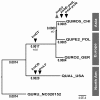Development of Molecular Markers for Determining Continental Origin of Wood from White Oaks (Quercus L. sect. Quercus)
- PMID: 27352242
- PMCID: PMC4924829
- DOI: 10.1371/journal.pone.0158221
Development of Molecular Markers for Determining Continental Origin of Wood from White Oaks (Quercus L. sect. Quercus)
Abstract
To detect and avoid illegal logging of valuable tree species, identification methods for the origin of timber are necessary. We used next-generation sequencing to identify chloroplast genome regions that differentiate the origin of white oaks from the three continents; Asia, Europe, and North America. By using the chloroplast genome of Asian Q. mongolica as a reference, we identified 861 variant sites (672 single nucleotide polymorphisms (SNPs); 189 insertion/deletion (indel) polymorphism) from representative species of three continents (Q. mongolica from Asia; Q. petraea and Q. robur from Europe; Q. alba from North America), and we identified additional chloroplast polymorphisms in pools of 20 individuals each from Q. mongolica (789 variant sites) and Q. robur (346 variant sites). Genome sequences were screened for indels to develop markers that identify continental origin of oak species, and that can be easily evaluated using a variety of detection methods. We identified five indels and one SNP that reliably identify continent-of-origin, based on evaluations of up to 1078 individuals representing 13 white oak species and three continents. Due to the size of length polymorphisms revealed, this marker set can be visualized using capillary electrophoresis or high resolution gel (acrylamide or agarose) electrophoresis. With these markers, we provide the wood trading market with an instrument to comply with the U.S. and European laws that require timber companies to avoid the trade of illegally harvested timber.
Conflict of interest statement
Figures



Similar articles
-
Species Identification of Oaks (Quercus L., Fagaceae) from Gene to Genome.Int J Mol Sci. 2019 Nov 26;20(23):5940. doi: 10.3390/ijms20235940. Int J Mol Sci. 2019. PMID: 31779118 Free PMC article.
-
Single-nucleotide polymorphism discovery and validation in high-density SNP array for genetic analysis in European white oaks.Mol Ecol Resour. 2015 Nov;15(6):1446-59. doi: 10.1111/1755-0998.12407. Epub 2015 Apr 6. Mol Ecol Resour. 2015. PMID: 25818027
-
Genetic variation and differentiation within a natural community of five oak species (Quercus spp.).Plant Biol (Stuttg). 2007 Jan;9(1):116-26. doi: 10.1055/s-2006-924542. Epub 2006 Oct 17. Plant Biol (Stuttg). 2007. PMID: 17048143
-
Microevolution of European temperate oaks in response to environmental changes.C R Biol. 2016 Jul-Aug;339(7-8):263-7. doi: 10.1016/j.crvi.2016.04.014. Epub 2016 Jun 2. C R Biol. 2016. PMID: 27263361 Review.
-
Taxonomy and identification of bacteria associated with acute oak decline.World J Microbiol Biotechnol. 2017 Jul;33(7):143. doi: 10.1007/s11274-017-2296-4. Epub 2017 Jun 16. World J Microbiol Biotechnol. 2017. PMID: 28623563 Free PMC article. Review.
Cited by
-
Artificial intelligence in timber forensics employing DNA barcode database.3 Biotech. 2023 Jun;13(6):183. doi: 10.1007/s13205-023-03604-0. Epub 2023 May 12. 3 Biotech. 2023. PMID: 37193334 Free PMC article.
-
Comparative analysis of two Korean irises (Iris ruthenica and I. uniflora, Iridaceae) based on plastome sequencing and micromorphology.Sci Rep. 2022 Jun 8;12(1):9424. doi: 10.1038/s41598-022-13528-z. Sci Rep. 2022. PMID: 35676304 Free PMC article.
-
Development and technical application of SSR-based individual identification system for Chamaecyparis taiwanensis against illegal logging convictions.Sci Rep. 2020 Dec 16;10(1):22095. doi: 10.1038/s41598-020-79061-z. Sci Rep. 2020. PMID: 33328522 Free PMC article.
-
Mitochondrial Genome of Fagus sylvatica L. as a Source for Taxonomic Marker Development in the Fagales.Plants (Basel). 2020 Sep 27;9(10):1274. doi: 10.3390/plants9101274. Plants (Basel). 2020. PMID: 32992588 Free PMC article.
-
Plastid Phylogenomic Data Offers Novel Insights Into the Taxonomic Status of the Trichosanthes kirilowii Complex (Cucurbitaceae) in South Korea.Front Plant Sci. 2021 Jul 27;12:559511. doi: 10.3389/fpls.2021.559511. eCollection 2021. Front Plant Sci. 2021. PMID: 34386020 Free PMC article.
References
-
- Cassens D. White oak. In: Hardwood lumber and veneer series. Purdue Extension (2007); FNR-292-W.
-
- US Department of Justice. Statement of facts, United States of American v. Lumber Liquidators. Case document 2:15-cr-00126-RAJ-LRL (2015). Available: http://www.justice.gov/opa/file/787141/download.
-
- Dormontt EE, Boner M, Braun B, Breulmann G, Degen B, Espinoza E, et al. Forensic timber identification: It's time to integrate disciplines to combat illegal logging. Biol Conserv (2015); 191:790–798.
MeSH terms
Substances
LinkOut - more resources
Full Text Sources
Other Literature Sources
Miscellaneous

